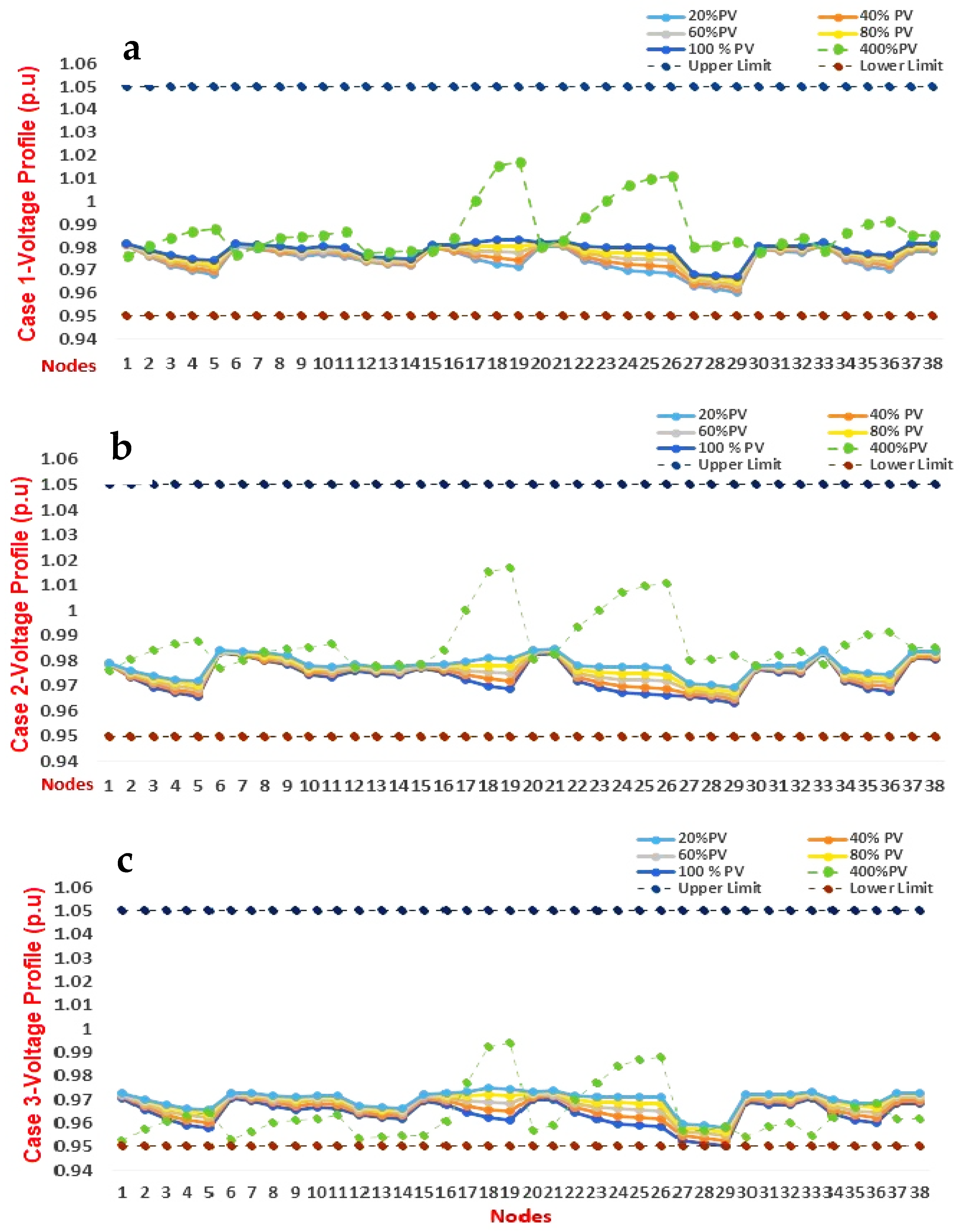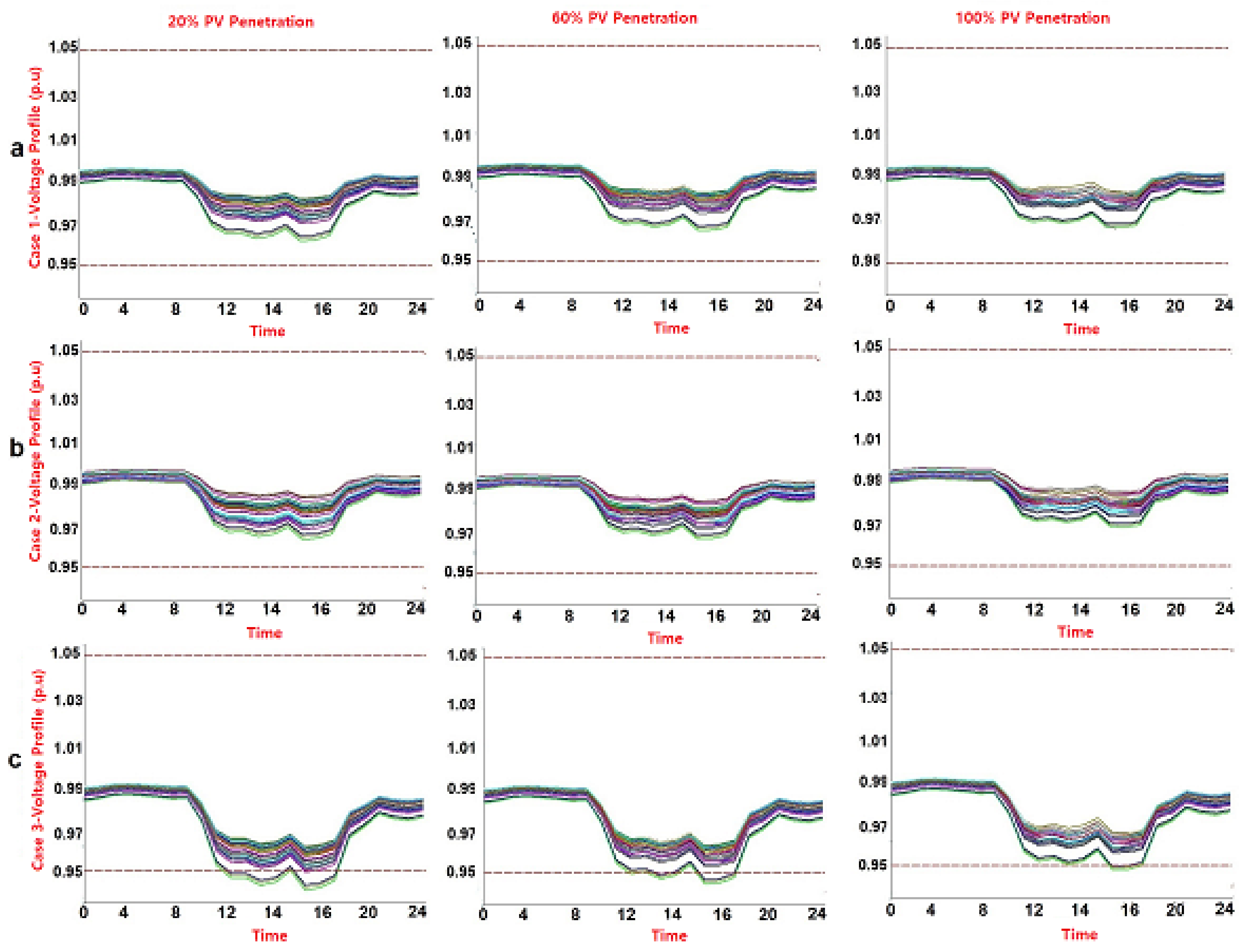Impact of Photovoltaic Penetration on Medium Voltage Distribution Network
Abstract
:1. Introduction
- To analyze power flow under different scenarios;
- To investigate short-circuit current and power loss of the network among different scenarios;
- To analyze dynamic simulations under different scenarios;
- To identify sensitive nodes and determine the maximum PV capacity.
2. Methodology
- Collecting grid and solar data, including the single-line schematic, load demand information, and PV generation data;
- Using a time-series framework to calculate power flow: a power flow calculation was made every minute, and the results displayed using Digsilent Power Factory to produce accurate results;
- Assessing overvoltage limits: in cases where the overvoltage limit is exceeded, this indicates that the maximum penetration of PV has already been achieved;
- Identifying the node with the highest voltage: nodes and buses with the highest voltage are reported when an overvoltage violation is detected;
- Running dynamic simulation under different scenarios.
2.1. PV Penetration Modeling
2.2. Network Topology Description
- The first scenario is a no-load condition, which is the state of the network when all the loads have been disconnected to see how much the PV penetration would affect the voltage profile in the grid;
- The second scenario is a peak load condition, which is the state of the network when all the loads have been connected to see how much the PV penetration would affect the voltage profile in the grid.
2.3. PV Penetration Level
2.4. Network Evaluation Strategies
2.5. Static Power Flow Analysis
2.6. Dynamic Power Flow Analysis
3. Results and Discussion
3.1. Static Analysis
3.2. Power Losses
3.3. Evaluation of Network under Short-Circuit Conditions
3.4. Dynamic Simulation under Peak Load Scenario
4. Conclusions
Author Contributions
Funding
Institutional Review Board Statement
Informed Consent Statement
Data Availability Statement
Acknowledgments
Conflicts of Interest
References
- Wu, S.; Liu, L.; Zhang, B.; Gao, Y.; Shang, L.; He, S.; Li, S.; Zhang, P.; Chen, S.; Wang, Y. Multifunctional two-dimensional benzodifuran-based polymer for eco-friendly perovskite solar cells featuring high stability. ACS Appl. Mater. Interfaces 2022, 14, 41389–41399. [Google Scholar] [CrossRef]
- Gervais, E.; Shammugam, S.; Friedrich, L.; Schlegl, T. Raw material needs for the large-scale deployment of photovoltaics–Effects of innovation-driven roadmaps on material constraints until 2050. Renew. Sustain. Energy Rev. 2021, 137, 110589. [Google Scholar] [CrossRef]
- Huang, J.; He, S.; Zhang, W.; Saparbaev, A.; Wang, Y.; Gao, Y.; Shang, L.; Dong, G.; Nurumbetova, L.; Yue, G. Efficient and Stable All-Inorganic CsPbIBr2 Perovskite Solar Cells Enabled by Dynamic Vacuum-Assisted Low-Temperature Engineering. Sol. RRL 2022, 6, 2100839. [Google Scholar] [CrossRef]
- Chua, S.C.; Oh, T.H. Solar energy outlook in Malaysia. Renew. Sustain. Energy Rev. 2012, 16, 564–574. [Google Scholar] [CrossRef]
- Maghami, M.R.; Gomes, C.; Hizam, H.; bin Othman, M.L. Design of 24 Hour Energy Generation from Renewable Energy. In Proceedings of the 2015 IEEE European Modelling Symposium, Madrid, Spain, 6–8 October 2015; pp. 284–287. [Google Scholar]
- Chaudhary, P.; Rizwan, M. Voltage regulation mitigation techniques in distribution system with high PV penetration: A review. Renew. Sustain. Energy Rev. 2018, 82, 3279–3287. [Google Scholar] [CrossRef]
- Bandara, W.G.C.; Almeida, D.; Godaliyadda, R.I.; Ekanayake, M.P.; Ekanayake, J. A complete state estimation algorithm for a three-phase four-wire low voltage distribution system with high penetration of solar PV. Int. J. Electr. Power Energy Syst. 2021, 124, 106332. [Google Scholar] [CrossRef]
- Imam, A.A.; Al-Turki, Y.A. Techno-economic feasibility assessment of grid-connected PV systems for residential buildings in Saudi Arabia—A Case Study. Sustainability 2019, 12, 262. [Google Scholar] [CrossRef] [Green Version]
- Wang, Q.; Yao, W.; Fang, J.; Ai, X.; Wen, J.; Yang, X.; Xie, H.; Huang, X. Dynamic modeling and small signal stability analysis of distributed photovoltaic grid-connected system with large scale of panel level DC optimizers. Appl. Energy 2020, 259, 114132. [Google Scholar] [CrossRef]
- Sreekumar, S.; Savier, J.S. Investigative scheme to assess ultimate penetration level of grid connected solar photovoltaic systems in distribution network. Int. Trans. Electr. Energy Syst. 2021, 31, e12647. [Google Scholar] [CrossRef]
- Coelho, F.C.R.; da Silva Junior, I.C.; Dias, B.H.; Peres, W.; Ferreira, V.H.; Marcato, A.L.M. Optimal distributed generation allocation in unbalanced radial distribution networks via empirical discrete metaheuristic and steepest descent method. Electr. Eng. 2021, 103, 633–646. [Google Scholar] [CrossRef]
- Ding, M.; Xu, Z.; Wang, W.; Wang, X.; Song, Y.; Chen, D. A review on China’s large-scale PV integration: Progress, challenges and recommendations. Renew. Sustain. Energy Rev. 2016, 53, 639–652. [Google Scholar] [CrossRef]
- Prusty, B.R.; Jena, D. A critical review on probabilistic load flow studies in uncertainty constrained power systems with photovoltaic generation and a new approach. Renew. Sustain. Energy Rev. 2017, 69, 1286–1302. [Google Scholar] [CrossRef]
- Allahvirdizadeh, Y.; Galvani, S.; Shayanfar, H. Data clustering based probabilistic optimal scheduling of an energy hub considering risk-averse. Int. J. Electr. Power Energy Syst. 2021, 128, 106774. [Google Scholar] [CrossRef]
- Almeida, D.; Pasupuleti, J.; Raveendran, S.K.; Khan, M.R.B. Monte Carlo analysis for solar PV impact assessment in MV distribution networks. Indones. J. Electr. Eng. Comput. Sci. 2021, 23, 23–31. [Google Scholar] [CrossRef]
- Atmaja, W.Y.; Putranto, L.M. A Voltage Rise Mitigation Control Scheme of Utility-Scale Battery in High PV Penetration. In Proceedings of the 2021 3rd International Conference on High Voltage Engineering and Power Systems (ICHVEPS), Bandung, Indonesia, 5–6 October 2021; pp. 634–639. [Google Scholar]
- Aleem, S.A.; Hussain, S.S.; Ustun, T.S. A review of strategies to increase PV penetration level in smart grids. Energies 2020, 13, 636. [Google Scholar] [CrossRef] [Green Version]
- Alsafasfeh, Q.; Saraereh, O.A.; Khan, I.; Kim, S. Solar PV grid power flow analysis. Sustainability 2019, 11, 1744. [Google Scholar] [CrossRef] [Green Version]
- Gaitán, L.F.; Gómez, J.D.; Rivas-Trujillo, E. Quasi-Dynamic Analysis of a Local Distribution System with Distributed Generation. Study Case: The IEEE 13 Nodes System. TecnoLógicas 2019, 22, 140–157. [Google Scholar] [CrossRef] [Green Version]
- DIgSilent, P.P. DIgSilent, Digsilent Powerfactory 15 User Manual. 2017, 1. Available online: https://www.digsilent.de/ (accessed on 12 February 2023).
- Raoofsheibani, D.; Henschel, D.; Hinkel, P.; Ostermann, M.; Wellssow, W.H.; Spanel, U. Quasi-dynamic model of VSC-HVDC transmission systems for an operator training simulator application. Electr. Power Syst. Res. 2018, 163, 733–743. [Google Scholar] [CrossRef]
- Gaitan, L.F.; Gómez, J.D.; Trujillo, E.R. Simulation of a 14 Node IEEE System with Distributed Generation Using Quasi-dynamic Analysis. Appl. Comput. Sci. Eng. 2018, 915, 497–508. [Google Scholar]
- Schneider, K.P.; Mather, B.; Pal, B.; Ten, C.-W.; Shirek, G.J.; Zhu, H.; Fuller, J.C.; Pereira, J.L.R.; Ochoa, L.F.; de Araujo, L.R. Analytic considerations and design basis for the IEEE distribution test feeders. IEEE Trans. Power Syst. 2017, 33, 3181–3188. [Google Scholar] [CrossRef]
- Kerdoum, P.; Premrudeepreechacharn, S. Analysis of PV penetration level on low voltage system in Chiang Mai Thailand. Energy Rep. 2020, 6, 754–760. [Google Scholar] [CrossRef]
- Bhatt, G.; Affljulla, S. Analysis of large scale PV penetration impact on IEEE 39-Bus power system. In Proceedings of the 2017 IEEE 58th International Scientific Conference on Power and Electrical Engineering of Riga Technical University (RTUCON), Riga, Latvia, 12–13 October 2017; pp. 1–6. [Google Scholar]







| Feeder | P (MW) | Q (MVAR) | Nodes |
|---|---|---|---|
| 1 | 0.085 | 0.043 | 1 |
| 2 | 2.929 | 1.465 | 2, 3, 4, 5 |
| 3 | 1.158 | 0.579 | 6, 7, 8,9 |
| 4 | 0.902 | 0.451 | 10, 11 |
| 5 | 3.249 | 1.624 | 12, 13, 14 |
| 6 | 2.169 | 1.085 | 15, 16, 17, 18, 19 |
| 7 | 0.485 | 0.243 | 20, 21 |
| 8 | 2.026 | 1.013 | 22, 23, 24, 25, 26, |
| 9 | 2.502 | 1.251 | 27, 28, 29 |
| 10 | 1.939 | 0.969 | 30, 31, 32 |
| 11 | 0.148 | 0.074 | 33 |
| 12 | 1.740 | 0.870 | 34, 35, 36 |
| 13 | 0.716 | 0.358 | 37, 38 |
| Total | 20.818 | 10.409 |
| Solar PV Penetration | Power Losses (kW) | |||
|---|---|---|---|---|
| Solar PV (kW) | Solar PV Percentage | Case Study 1 | Case Study 2 | Case Study 3 |
| 0 | 0% | 178 | 180 | 191 |
| 100 | 20% | 152 | 152 | 165 |
| 200 | 40% | 136 | 137 | 145 |
| 300 | 60% | 121 | 122 | 129 |
| 400 | 80% | 108 | 109 | 110 |
| 500 | 100% | 96 | 97 | 104 |
| 2000 | 400% | 826 | 827 | 866 |
| Solar PV Penetration | Short-Circuit Current (A) | ||||||
|---|---|---|---|---|---|---|---|
| Solar PV (kW) | Solar PV Percentage | Case Study 1 | Case Study 2 | Case Study 3 | |||
| 33 kV Bus | 11 kV Bus | 33 kV Bus | 11 kV Bus | 33 kV Bus | 11 kV Bus | ||
| 0 | 0% | 22,500 | 10,494 | 22,500 | 12,461 | 22,500 | 12,461 |
| 100 | 20% | 22,524 | 10,509 | 22,524 | 12,475 | 22,525 | 12,486 |
| 200 | 40% | 22,550 | 10,527 | 22,550 | 12,490 | 22,553 | 12,519 |
| 300 | 60% | 22,578 | 10,547 | 22,578 | 12,508 | 22,583 | 12,558 |
| 400 | 80% | 22,604 | 10,567 | 22,604 | 12,523 | 22,612 | 12,598 |
| 500 | 100% | 22,628 | 10,586 | 22,628 | 12,540 | 22,640 | 12,638 |
| Solar PV Penetration | Short-Circuit Current (A) | ||||||
|---|---|---|---|---|---|---|---|
| Solar PV (kW) | Solar PV Percentage | Case Study 1 | Case Study 2 | Case Study 3 | |||
| 33 kV Bus | 11 kV Bus | 33 kV Bus | 11 kV Bus | 33 kV Bus | 11 kV Bus | ||
| 0 | 0% | 22,479 | 12,461 | 22,479 | 12,461 | 22,479 | 12,413 |
| 100 | 20% | 22,505 | 12,478 | 22,505 | 12,478 | 22,507 | 12,437 |
| 200 | 40% | 22,533 | 12,499 | 22,533 | 12,499 | 22,538 | 12,468 |
| 300 | 60% | 22,562 | 12,522 | 22,562 | 12,522 | 22,571 | 12,505 |
| 400 | 80% | 22,589 | 12,547 | 22,590 | 12,547 | 22,603 | 12,544 |
| 500 | 100% | 22,614 | 12,569 | 22,615 | 12,569 | 22,632 | 12,582 |
Disclaimer/Publisher’s Note: The statements, opinions and data contained in all publications are solely those of the individual author(s) and contributor(s) and not of MDPI and/or the editor(s). MDPI and/or the editor(s) disclaim responsibility for any injury to people or property resulting from any ideas, methods, instructions or products referred to in the content. |
© 2023 by the authors. Licensee MDPI, Basel, Switzerland. This article is an open access article distributed under the terms and conditions of the Creative Commons Attribution (CC BY) license (https://creativecommons.org/licenses/by/4.0/).
Share and Cite
Maghami, M.R.; Pasupuleti, J.; Ling, C.M. Impact of Photovoltaic Penetration on Medium Voltage Distribution Network. Sustainability 2023, 15, 5613. https://doi.org/10.3390/su15075613
Maghami MR, Pasupuleti J, Ling CM. Impact of Photovoltaic Penetration on Medium Voltage Distribution Network. Sustainability. 2023; 15(7):5613. https://doi.org/10.3390/su15075613
Chicago/Turabian StyleMaghami, Mohammad Reza, Jagadeesh Pasupuleti, and Chee Mei Ling. 2023. "Impact of Photovoltaic Penetration on Medium Voltage Distribution Network" Sustainability 15, no. 7: 5613. https://doi.org/10.3390/su15075613







